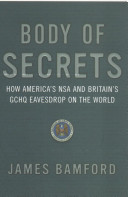In a just-published book, author James Bamford once again charges that Israel intentionally and knowingly attacked a US spy ship, the USS Liberty, during the 1967 Six Day War. Though he claims to have uncovered new evidence, the charges in Body of Secrets (Doubleday) directly parallel demonstrably false charges Bamford leveled in his earlier book, The Puzzle Palace. For this reason, neither Bamford’s charges nor his “new evidence” deserve much credibility.
For example, consider what Bamford agrees is an absolutely key point, the question of motive. Why would Israel, in the midst of a three-front war against Soviet-supported Arab regimes, intentionally attack what it knew to be a US Navy ship? Bamford offers a number of related reasons, all hinging on Israel’s alleged obsession with maintaining absolute secrecy. Thus, in Puzzle Palace, Bamford argued that Israel attacked the Liberty on June 8th to prevent the US from knowing the extent of Israeli victories in the war and to prevent the imposition of a cease-fire:
By Wednesday, June 7, nearly all [Arab] resistance had been eliminated. Nevertheless, an essential element in the Israeli war plan was complete secrecy about all the details of the true extent of the Israeli penetration into Arab territory as well as the size and scope of its military victories. Vital to the Israeli strategy was the prevention, for as long as possible, of any cease-fire imposed by any of the superpowers. (The Puzzle Palace, p. 221-222)
There is a devastating flaw in Bamford’s logic – the “true extent” of Israeli victories was well known before the Liberty was attacked on June 8, 1967. Thus, on June 7th the New York Times featured a large three-column front-page story by James Reston headlined “Israelis Think the War Has Been Won.” And on the very day the Liberty was attacked, banner headlines in the New York Times literally screamed the news: Israelis Rout the Arabs, Approach Suez, Break Blockade, Occupy Old Jerusalem; Agree to U.N. Cease-Fire; U.A.R. Rejects It (New York Times, June 8, 1967).

Perhaps Mr. Bamford will someday explain just how those clever Israelis managed to prevent the President and his advisers from noticing these headlines.
Also, as the headline indicates, and further contradicting Bamford’s reckless allegations, Israel accepted the U.N. cease-fire while Egypt (ie, the U.A.R. ) rejected it. Why would Israel attack the Liberty to prevent a cease-fire which Israel had already accepted?
Bamford offers no explanation for this, either in Puzzle Palace or in his new book, Body of Secrets, which recycles many of his old canards, and adds a few new ones. Again harping on Israel’s desire for secrecy, Bamford once more argues that the Liberty was attacked because “an essential element in the Israeli battle plan seemed to have been to hide much of the war behind a carefully constructed curtain of lies.” (p 203)
Actually, hiding “behind a carefully constructed curtain of lies” is about as self-descriptive a phrase as Bamford could have written. And the crux of Bamford’s new curtain is an explosive charge sure to grab headlines and drive book sales, especially in certain circles. For, according to Bamford, among the secrets the Israelis were desperate to hide from the prying eyes of the USS Liberty were alleged war crimes against Egyptian POWs near the coastal town of El Arish, not far from the ship’s position on June 8th. Bamford charges that Israel turned El Arish into a “slaughterhouse, systematically butchering their prisoners” (p 202), and attacked the Liberty to prevent these crimes from being discovered.
Again, there is a devastating flaw in Bamford’s logic – the “slaughter” never occurred. But even if it had, the reports Bamford cites offer no support for his claim that Israel attacked the Liberty and murdered US soldiers to cover-up its murder of Egyptian soldiers.
That said, there were press reports in 1995 alleging that Egyptian POWs were murdered during the 1967 Six Day War, and Bamford cites some of these to support his charges. However, a number of the reports cited by Bamford also note that Israeli eyewitnesses denied any such thing occurred. Bamford keeps this from his readers. These same reports also indicate that Israeli POWs were killed by their Arab captors. Again, Bamford never mentions this, intent on painting a one-sided portrait of bloodthirsty Israelis. Finally, Bamford also ignores the fact that later investigations refuted the claim that the alleged massacres of Egyptian POWs ever took place.
Beyond omitting such relevant information, Bamford also invents information not in the references he cites. Nothing could be more revealing of Bamford’s shoddy research and irrational animus towards Israel than to compare his charges with the sources he cites, and with the facts. Bamford’s key charges concerning the alleged Israeli massacre as the reason for attacking the Liberty appear in four consecutive paragraphs on pages 201 – 202 (for convenience the paragraphs are numbered):
1. By June 8, three days after Israel launched the war, Egyptian prisoners in the Sinai had become nuisances. There was no place to house them, not enough Israelis to watch them and few vehicles to transport them to prison camps. But there was another way to deal with them.
2. As the Liberty sat within eyeshot of El Arish, eavesdropping on surrounding communications, Israeli soldiers turned the town into a slaughterhouse, systematically butchering their prisoners. In the shadow of the El Arish mosque, they lined up about sixty unarmed Egyptian prisoners, hands tied behind their backs, and then opened up with machine guns until the pale desert sand turned red. Then they forced other prisoners to bury the victims in mass graves. “I saw a line of prisoners, civilians and military,” said Abdelsalam Moussa, one of those who dug the graves, “and they opened fire at them all at once. When they were done, they told us to bury them.” Nearby, another group of Israelis gunned down thirty more prisoners and then ordered some Bedouins to cover them with sand.
Of course, contrary to Bamford’s charges here and elsewhere in the book, Israel did not “launch” the war. Egypt’s blockade of Eilat, Israel’s southern port, and its blockade of the Straits of Tiran, an international waterway, were both acts of war under international law. And prior to the major outbreak of shooting on June 5th, there were numerous incidents of Egyptian fire against Israeli positions, any one of which justified retaliation in force. Bamford ignores this, just as he ignores relevant evidence in order to charge in the second paragraph that Israel turned El Arish “into a slaughterhouse.”
Bamford cites two sources for the second paragraph, an article from the New York Times and one from Newsday, which according to Newsday’s archives was actually an AP story. Neither article mentions anything at all about the “El Arish mosque,” neither mentions anything at all about prisoners with their “hands tied behind their backs,” and neither mentions anything at all about how the “pale desert sand turned red.” All this is apparently straight from Mr. Bamford’s overheated imagination, making one wonder what else he made up.
The New York Times story, by Youseff Ibrahim and dated September 21, 1995, does contain the quote from Abdelsalam Moussa, who claimed to be an eyewitness to the killing of 30 to 60 POWs. But – and this is crucial – the report does not indicate when the killings described by Moussa took place, before the Liberty arrived, or while it was on station off El Arish. However, a Reuters dispatch published in the Jerusalem Post (September 21, 1995), reports Moussa as saying that the killings he claims to have seen took place on June 7, which was before the Liberty arrived! Thus, contrary to Bamford’s charge, the attack on the Liberty could not have been to prevent the ship from discovering the Israeli slaughter alleged by Moussa.
Mr. Bamford also takes from Ibrahim’s report the story of the Israelis supposedly gunning down 30 more prisoners and then ordering some Bedouins to bury them. According to Ibrahim however, these episodes took place on June 6 and June 7, two days and one day before the Liberty even arrived off El Arish. So, again, Bamford deceptively cites this episode even though it clearly offers no support for his thesis.
Ibrahim also notes the curious fact that Moussa had not come forward sooner, attributing this to the Egyptian government’s supposed desire not to delve into such issues after it recovered the Sinai from Israel in the early 1980’s, but this certainly does not explain why the Egyptians would not have trumpeted Moussa’s claims in the twelve years between the war and the peace treaty with Israel in 1979. Deceptively, Bamford keeps this too from his readers.
The AP story which Bamford cites to support his claims in this paragraph (dated August 16, 1995; it ran in Newsday the following day), actually has nothing to do with the details of the paragraph. There is no mention of Abdelsalam Moussa and no mention of the Bedouins. While the article does mention killings in El Arish, it dates them to June 9-10, after the attack on the Liberty. If Bamford considers this article a credible source, then whatever happened in the episode it describes clearly had nothing to do with the attack on the Liberty. But Bamford deceptively keeps this from his readers as well. And, so eager is he to paint the Israelis as latter-day Nazis, he also hides from readers another relevant passage in this AP article, which stated that the alleged killings of Egyptians occurred when “some of the prisoners opened firing after surrendering and shot dead two Israeli soldiers.”
Bamford’s deceptions continue in the third paragraph, with yet more fabricated details about an event which may or may not have occurred:
3. In still another incident at El Arish, the Israeli journalist Gabi Bron saw about 150 Egyptian POWs sitting on the ground, crowded together with their hands held at the back of their necks. “The Egyptian prisoners of war were ordered to dig pits and then army police shot them to death,” Bron said. “I witnessed the executions with my own eyes on the morning of June eighth, in the airport area of El Arish.”
Did Gabi Bron, as Bamford claims, see Israeli soldiers slaughter 150 bound Egyptian prisoners? Bamford cites as his source a New York Times article by Serge Schmemann dated August 21, 1995. While this article does contain the quoted passage from Bron, it says not a word about the number of Egyptians shot or even the number seen by Bron. Where did Bamford get the number of victims as 150? He doesn’t say. The article also doesn’t mention anything about prisoners “sitting on the ground, crowded together with their hands held at the back of their necks.” This is apparently another creation of Bamford’s all-too-fertile imagination. However, another AP article dated August 17, 1995, which Bamford seems not to quote, gives the number of killed according to Gabi Brun (the spelling is slightly different) as five, not 150. In addition, according to the article, Brun’s commanding officer, who was also there at the time, denied that there were any executions at all. If he is wrong, and these executions did occur, it was clearly inexcusable but would hardly qualify as Bamford’s “slaughterhouse.”
And that brings us to the final paragraph, concerning an alleged report on alleged Israeli war crimes written by an alleged historian:
4. The Israeli military historian Aryeh Yitzhaki, who worked in the army's history department after the war, said he and other officers collected testimony from dozens of soldiers who admitted killing POWs. According to Yitzhaki, Israeli troops killed, in cold blood, as many as 1000 Egyptian prisoners in the Sinai, including some 400 in the sand dunes of El Arish. (Body of Secrets, p 201-202)
Was Aryeh Yitzhaki an “Israeli military historian,” and did he collect evidence that “Israeli troops killed, in cold blood, as many as 1,000 Egyptian prisoners?” Perhaps because Yitzhaki’s claims are so incendiary, Bamford cites two sources, both dated August 17, 1995: an article from the Washington Post, and the already cited article from Newsday. That these articles are from the same date, however, is no accident – they are, with cuts, the same AP article (datelined August 16)! If this was not an honest mistake, then it was only the beginning of Bamford’s deceptions concerning Yitzhaki.
For the AP article of the next day, August 17, revealed that Yitzhaki, a member of a far-right political party in Israel, admitted he came out with his charges to protect the leader of his party, who had just been indirectly implicated in some genuine killings of Egyptian POWs in the 1956 Middle-East war. According to the AP, Yitzhaki “acknowledged that he spoke out mainly to shift attention … from Tzomet leader Raphael Eitan … to leading government officials, including Prime Minister Yitzhak Rabin.” That Yitzhaki’s credibility was therefore shaky at best is another fact kept from readers by Bamford.
In addition, a Jerusalem Post story of August 17, 1995 quoted Yitzhaki’s then-commanding officer, historian Meir Pa’il, who stated that in 1968 Yitzhaki was not a military historian at all, but rather a mere clerk:
He was a clerk in the department's archive. In 1968, he was an assistant of mine when I conducted a comparative study of the conquests of Sinai in 1948, 1956, and 1967. Had he stumbled on these devastating so-called facts, he would have said so then. The fact is he didn't.
This report also states that “transcripts of orders from the Six Day War shown to the Jerusalem Post yesterday clearly indicate that the alleged mass murder of Egyptian POWs near El-Arish never occurred as described by [Aryeh Yitzhaki].”
According to the Post, what actually happened was a full-fledged battle between soldiers:
… several hundred armed Palestinian soldiers, in Egyptian Army uniforms, were trying to escape from the Gaza Strip towards Port Said – not knowing that the area was already under IDF control – on the last day of the war [with Egypt]. They exchanged fire with Nahal soldiers and most were later killed by soldiers from the Shaked reconnaissance unit.
Supporting this is a contemporaneous account from the New York Times, which reported precisely such battles, but no massacres. Datelined El-Arish, June 7, the Times article reported that:
… pockets of Egyptian troops in Sinai and Palestinian troops in the Gaza Strip continued desperate resistance…
The army base here was also in Israeli hands yesterday evening after a three hour battle. Heavy casualties were inflicted, more than a thousand prisoners surrendered and some Egyptian soldiers fled into the desert.
At dawn today an Egyptian commando company struck back. An officer told reporters that the enemy had stormed the camp at daybreak with submachine guns blazing. They inflicted casualties, but were gunned down.
Later this morning, when a battalion commander went toward the home of the governor to arrange for a formal surrender, fire was opened from several houses in the town. The Israelis withdrew, and orders were given to subdue the enemy by shelling.
Brief and sporadic bursts of machinegun fire were heard between mortar blasts. Reporters were told that Egyptians were being flushed out of stone-lined trenches around the town. (New York Times, June 8, 1967; emphasis added)
Perhaps as important as the corroborating details offered by this account, is the affirmation that in El Arish on June 7th Israeli forces were accompanied by reporters who evidently neither saw nor heard even a hint of Bamford’s alleged “slaughterhouse.”
And not just reporters; photographers also accompanied the Israeli troops throughout their advance into the Sinai. Indeed, an American photographer for Life Magazine, Paul Schutzer, was killed while riding with Israeli troops in a half-track that came under Egyptian attack. Despite the dangers, these news photographers, both Israeli and foreign, filed numerous battle images, as well as photos of the war’s immediate aftermath, such as Israeli soldiers dealing with Arab POWs in El Arish during the very time that Bamford charges there was an ongoing slaughter:
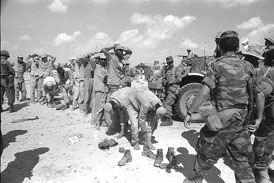 |
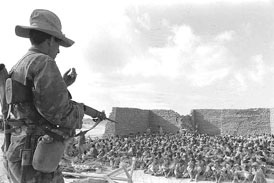 |
|
| June 7, 1967: Egyptian POWs being rounded up outside El Arish (Shabtai Tal) | June 7, 1967: Israeli soldier guards Egyptian POW's at El Arish (Shabtai Tal) |
The photographers also recorded Israeli doctors tending to wounded POWs. Why the Israelis would bother to provide advanced medical care to POWs while they were at the same time slaughtering them is unclear:
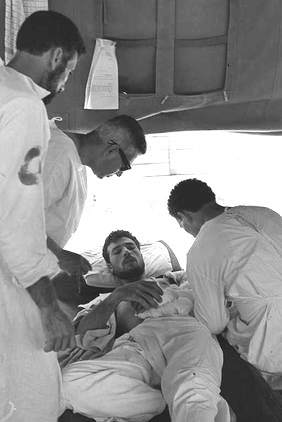 |
| June 26, 1967: Wounded POW receives care at the hospital in the Atlit POW compound in Israel. (Moshe Pridan) |
Some of the wounded Egyptian POWs bade a friendly goodbye as they were being repatriated to Egypt:
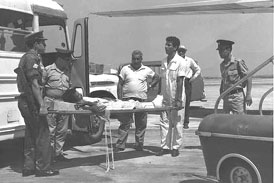 |
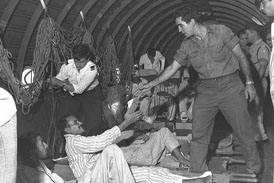 |
|
| July 31, 1967: After Israeli treatment wounded Egyptian POWs are carried to a Red Cross ambulance plane for the trip to Cairo. | July 31, 1967: In Red Cross ambulance plane a wounded Egyptian POW says goodbye to an Israeli. |
Many passages in Body of Secrets and Puzzle Palace display Bamford’s fanatical animus towards Israel and its American – especially Jewish-American – supporters, which perhaps explains why he would publish such nonsense. There are also numerous apparently careless errors which further undermine Bamford’s believability.
But the bottom line is that merely consulting old newspapers and old photographs is enough to demolish Bamford’s new conspiracy theories. Case closed.
Addendum: Confronted with facts, Bamford tells new lies
Confronted on the NPR program The Connection with the fact that contemporaneous press reports, including New York Times accounts from June 1967, contradict his anti-Israel conspiracy theories, Bamford tried to confuse listeners by acting as if the issue were a recent Times review of Body of Secrets. In the process, Bamford also grossly misrepresented the review, which raised serious questions about his Liberty allegations and his ability to write credibly on Israel. Indeed, the reviewer, Joseph Finder, called the chapter on the Liberty the “weakest” part of the book and speculates that perhaps Bamford’s “palpable distaste for the Israeli state” had clouded his judgement.
Whatever the explanation for Bamford’s willingness to deceive, a comparison shows that his characterization of the review is no more credible that his writing on Israel. Here is Bamford’s version of the review:
BAMFORD: The New York Times as a matter of fact reprinted almost verbatim a lot of my information on the Liberty just two weeks ago without any critical comment whatsoever. The New York Times just this past Sunday had my book on the front cover of the … Book Review. I don’t think that’s an indication that they have some worries about my credibility. And the review was actually very, very good, saying that it was an extraordinary work of investigative journalism. That doesn’t sound critical to me. (The Connection, May 3, 2001)
Now, compare that with the relevant portion of the Times review:
Where “Body of Secrets” is weakest, I think, is in its account of the most horrific incident in the N.S.A.'s history, the assault on the spy ship Liberty a few miles off the Sinai peninsula during the 1967 Middle East war. On orders from the Joint Chiefs of Staff, the N.S.A. had sent the Liberty into the war zone to collect intelligence on the presence of Soviet troops and weapons in Egypt. On the afternoon of June 8, 1967, the Liberty was attacked by Israeli forces; 34 Americans were killed, 171 wounded. Was it, as Israel maintained, a “tragic accident”? Or was it, as conspiracy theorists and some of the ship's survivors insist, a coldblooded and deliberate action by the Israelis in order to eliminate evidence of damaging information the Liberty had intercepted?
Rather too credulously, Bamford sides with the conspiracy theorists. He argues that the Israelis were attempting to cover up a gruesome mass murder by Israeli soldiers of some 400 Egyptian P.O.W.'s at the Sinai town of El Arish. Israel, Bamford claims, acted because it was convinced that the N.S.A. ship was recording intelligence on this massacre. “Israeli soldiers were butchering civilians and bound prisoners by the hundreds,” he writes, “a fact that the entire Israeli Army leadership knew about and condoned.” He charges, too, that the White House and Congress “covered up” the facts of the attack. But is it really possible that such an explosive secret could have been kept under wraps for so long by the Johnson administration, the United States Congress and all of the famously fractious Israeli Army leadership?
And what serious evidence is there that a massacre of 400 Egyptians really took place? Bamford's own proof seems rather slender. He cites, for instance, the eyewitness testimony of an Israeli journalist, Gabi Bron. Bamford writes: “Bron saw about 150 Egyptian P.O.W.'s sitting on the ground, crowded together with their hands held at the backs of their necks. 'The Egyptian prisoners of war were ordered to dig pits and then army police shot them to death,' Bron said.” The implication here is that 150 Egyptians were slaughtered. Yet the journalist's full account actually states, “I saw five prisoners killed this way” — a brutal war crime if true, yes, but of quite a different magnitude.
It hardly seems plausible that Israel would deliberately attack an American ship, killing dozens of American sailors, risking a confrontation with a superpower and its only ally — in short, perpetrating one massacre in order to cover up another. Perhaps Bamford's analysis has been skewed by his palpable distaste for the Israeli state: “Throughout its history, Israel has hidden its abominable human rights record behind pious religious claims,” he writes. “Critics are regularly silenced with outrageous charges of anti-Semitism.” And: “No one in the weak-kneed House and Senate wanted to offend powerful pro-Israel groups and lose their fat campaign contributions.” (excerpted from New York Times Book Review, April 29, 2001)
This, according to Bamford, is an endorsement of his credibility and his allegations concerning Israel. In other words, not only can’t Bamford be trusted about what happened in 1967, he can’t even be trusted about what happened a week ago.
By Alex Safian, PhD

